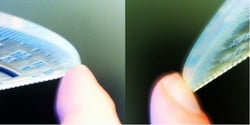Gummi bears have more to teach us about measurement systems analysis.
Today, we’ll look at doing a Type 1 Gage Study, which compares the measurement variation to the specifications for your process, to judge whether a gage is measuring well enough. The Type 1 Gage Study is a starting point because it evaluates accuracy, precision, and consistency, but only for a single case. Later, we’ll look at the Gage Linearity and Bias Study and the Gage R&R Study.
I’ve mentioned that we will study the effect of different factors on how far a gummi bear flies, but the real goal of knowledge about factor effects is usually to minimize, maximize, or target a response variable. My target will be a CD. Choosing a target lets me provide specifications for the Type 1 Gage Study.
- Sadly, we still don’t need the catapult, and we only need one gummi bear. Here’s what you do:
- Place the gummi bear at a spot where you know the distance from your starting point. I'm using the diagonal distance of my computer monitor, 23 inches.
Measure the location of the gummi bear 25 times.
This can seem a little tedious because the Type I Gage Study is evaluating a measurement tool. Most rulers and tape measures are very accurate in this day and age, so I’m going to choose a tool that makes the measurement process harder: a 6-inch protractor. Here's what I got:
| Order | Measurement |
|---|---|
| 1 | 22.7500 |
| 2 | 22.6875 |
| 3 | 22.9375 |
| 4 | 22.7500 |
| 5 | 22.8125 |
| 6 | 22.6875 |
| 7 | 22.7500 |
| 8 | 22.7500 |
| 9 | 22.8125 |
| 10 | 22.6875 |
| 11 | 22.7500 |
| 12 | 22.9375 |
| 13 | 22.8750 |
| 14 | 22.8750 |
| 15 | 22.6875 |
| 16 | 22.8750 |
| 17 | 22.8125 |
| 18 | 22.6875 |
| 19 | 22.8125 |
| 20 | 22.7500 |
| 21 | 23.0000 |
| 22 | 22.8750 |
| 23 | 22.8125 |
| 24 | 22.7500 |
| 25 | 22.8750 |
Now we can use this data to perform a Type 1 Gage Study in Minitab Statistical Software:
- Choose Stat > Quality Tools > Gage Study > Type 1 Gage Study.
- In Measurement Data, enter the column where you have your measurements.
- In Reference, enter the known distance to the gummi bear. Mine was 23 inches.
- In Upper spec – lower spec, enter 4.5, for the diameter of a CD. You can enter a different number if you choose a different target. Click OK.
My results looked like this:

The most interesting part to me was that my bias was negative: my measurements were too short. I had thought that the measurements would be thrown off most by not moving the protractor in a straight line, so I would end up with measurements that were too long. As it turned out, the real problem was twofold:
- My protractor didn’t go all the way back into the corner of the computer monitor.

- From the tip of my fingernail to the rounded part of my fingernail is a longer distance than I’d expected when you add it in 3 times.

You’ll make all kinds of unexpected discoveries when you use measurement systems analysis. The practice that you get collecting simple data to build your confidence will help you think about the issues you will encounter in more complex quality improvement tasks.
In my next post, I’ll look at how bias might shrink or grow depending on how large a measurement you take using a Gage Linearity and Bias Study.



